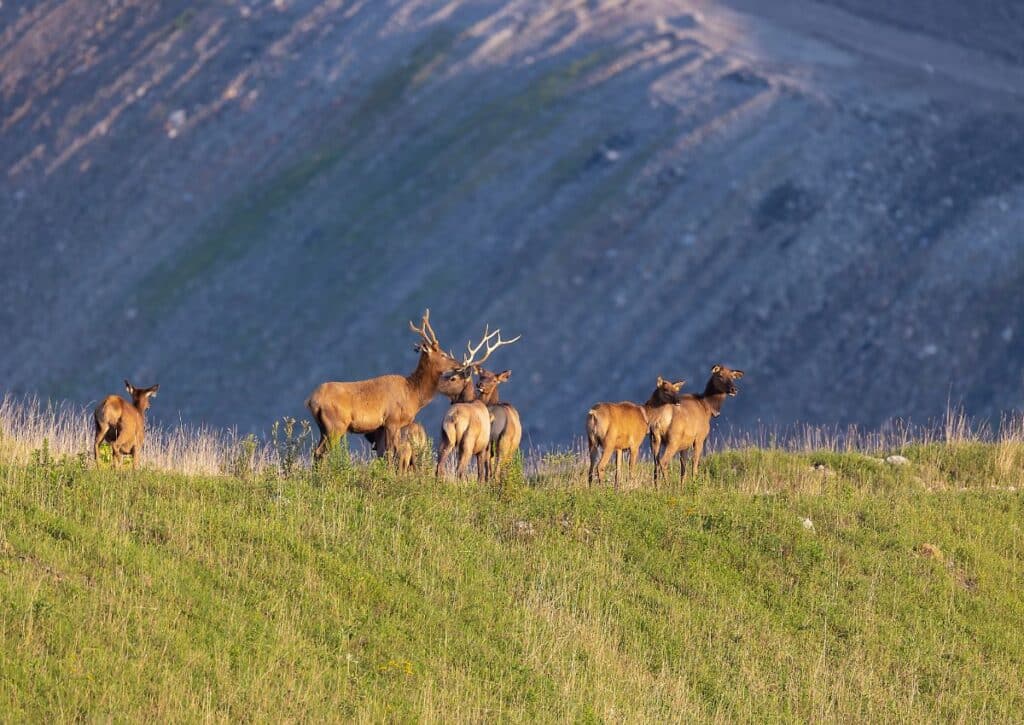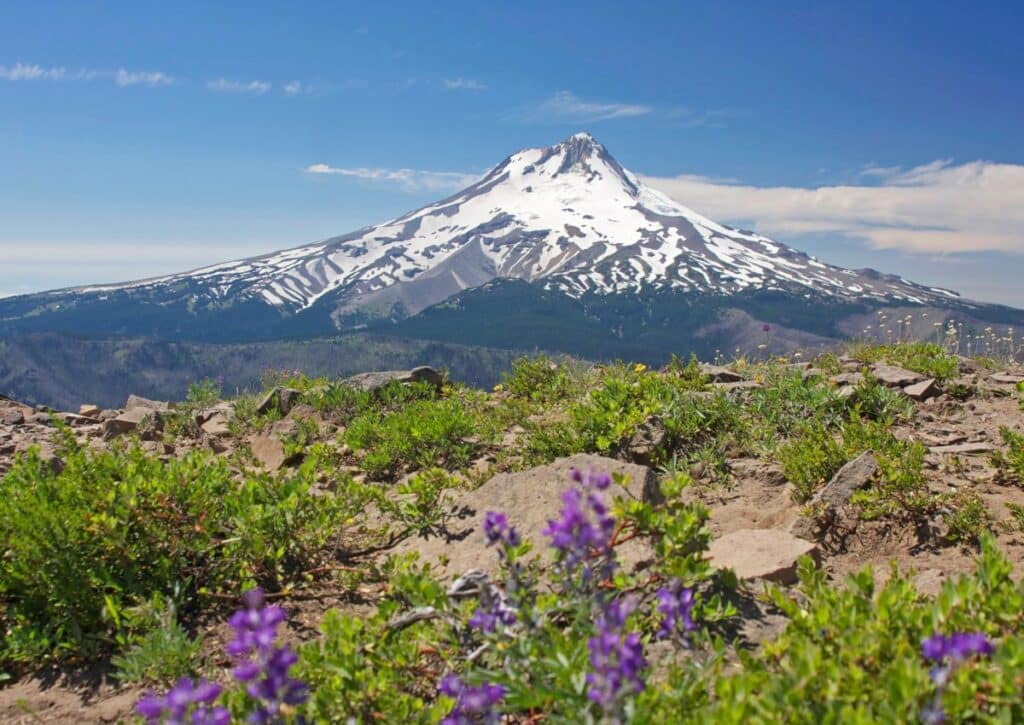Discover 21 animals in the Mount Hood National Forest with our guide on best trails and sighting tips.
We’ve hiked in Mount Hood National Forest many times in the last 3 decades. We have had memorable wildlife encounters in everything we’ve ventured in, and the forest has always surprised us!
Mount Hood National Forest spans over a million acres, each corner teeming with life. This vast expanse, with its varied habitats from dense woods to open meadows, is home to abundant wildlife.
In this article, we’ll share our most memorable encounters and offer insights into the creatures that have made our hikes extraordinary. If you’ve ever been curious about the wildlife of Mount Hood or are planning a visit, this is a must-read.
Roosevelt Elk
The Roosevelt Elk stands as one of the most majestic sights in Mount Hood National Forest. Recognizable by their solid build, males can weigh up to 1,100 pounds. Their contrasting dark brown heads and pale beige bodies, coupled with large antlers that can span up to six feet, make them a remarkable sight.
For those of you planning hikes in Mount Hood, there’s good news. The forest’s lower elevations, especially around the Zigzag River and Salmon River areas, are prime territories for these elks.
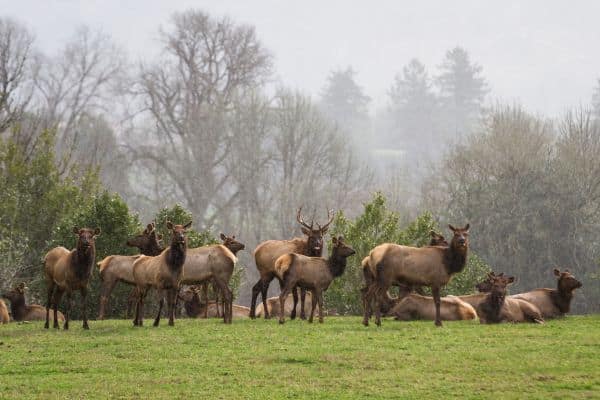
The Timberline Trail, a roughly 40-mile loop encircling Mount Hood, offers several spots where you might catch a glimpse of these majestic animals.
Additionally, the Lost Creek Trail, a shorter 5.2-mile round trip trek, is another hotspot for elk sightings, particularly in the early mornings or late afternoons.
In terms of behavior, Roosevelt Elks are social and can often be seen in groups. The echoing calls or “bugling” of the males can be heard during fall, signaling the mating season.
It’s always a thrill to witness, but a word of caution: while it’s tempting to get a closer look or photograph, always maintain a respectful distance.
Their sheer size and territorial nature, especially during mating season, mean they can be unpredictable. Safe and responsible wildlife watching ensures both your safety and the well-being of these incredible creatures.
Black Bear
One of the most exhilarating experiences we can have in Mount Hood National Forest is encountering a Black Bear. These bears, predominantly covered in sleek black fur, can also exhibit cinnamon or brown shades.
Adult black bears typically weigh between 100 to 500 pounds, with males being generally larger than females. Their keen sense of smell, strong physique, and rounded ears distinguish them from other North American bears.
If you’re keen on spotting one, your best bet lies in the forest’s dense woodlands and remote areas. The areas surrounding Trillium Lake and the thickets along the Sandy River have had notable bear sightings.
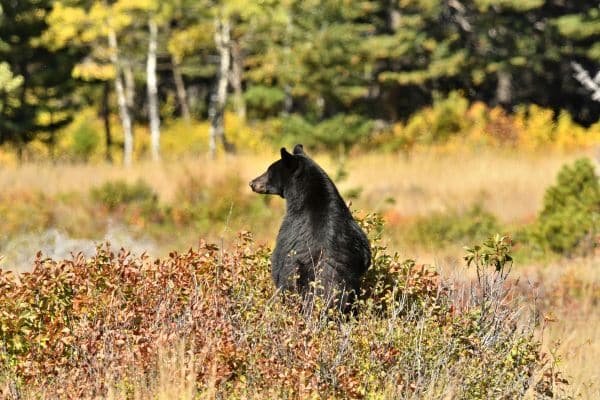
For hikers, the Ramona Falls Trail, spanning around 7 miles, and the Burnt Lake Trail, a 7.5-mile round trip, are prime trails where black bears have been occasionally observed, especially during dawn or dusk.
While Black Bears are typically shy and often avoid human interaction, it’s crucial for us to be bear-aware. They are highly opportunistic feeders, and the scent of food can attract them to campsites.
If you’re hiking or camping in bear country, store your food securely and be cautious about leaving scraps behind. And, as always, if you do encounter a bear, it’s recommended to speak calmly, avoid direct eye contact, and slowly back away.
An encounter with a Black Bear in the wild is a memorable experience, but respecting their space ensures the safety of both you and the bear.
Mountain Beaver
A lesser-known resident of Mount Hood National Forest, but equally fascinating, is the Mountain Beaver. Don’t let the name deceive you; this isn’t your typical beaver.
These creatures are relatively small, typically weighing around 2 to 4 pounds. Covered in dense brown or black fur, they have short legs, a stubby tail, and long claws ideal for digging.
If you’ve walked the damp woods and riparian areas of the forest, you’ve likely been in Mountain Beaver territory. The surroundings of Clear Lake and the dense underbrush along Still Creek have been known as areas where these elusive creatures reside.
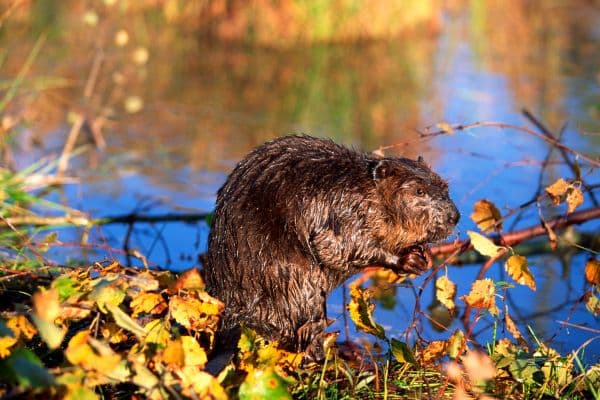
On trails, the Old Salmon River Trail, a gentle 5-mile pathway, and the Pioneer Bridle Trail, stretching about 10 miles, are areas where you might stumble upon signs of their burrows or feeding activity.
Mountain Beavers are predominantly herbivores, with a diet comprising ferns, shrubs, and tree seedlings. They play a vital role in the ecosystem by aerating the soil through their digging activities. If you happen to spot one during your hikes, it’s likely they’ll be foraging or busy working on their burrow systems.
As with all wildlife encounters, it’s essential to observe from a distance and not disturb their natural behaviors. Their unique way of life and importance to the forest ecosystem make the Mountain Beaver a fascinating subject of observation.
Mountain Lions
The Mountain Lion, also known as the cougar or puma, is one of the most formidable and awe-inspiring residents of Mount Hood National Forest. These apex predators have a sleek and muscular build, with adults typically weighing between 80 to 220 pounds.
Their tawny or grayish coat, white underparts, and long, heavy tail with a dark tip make them distinct. Their powerful limbs are built for hunting and climbing.
For those trekking through Mount Hood, the dense forested areas with plenty of underbrush offer the best chance of spotting signs of these elusive cats. The remote regions near Cooper Spur and the rugged terrains around Badger Creek Wilderness have seen occasional mountain lion activity.
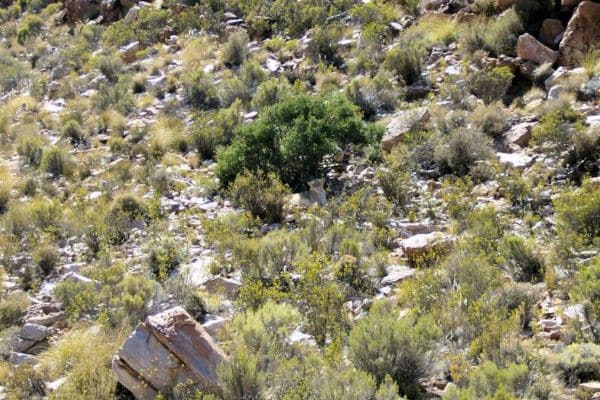
Trails like the Tamanawas Falls Trail, a 3.6-mile journey, or the longer Timberline Trail might offer the very rare chance of spotting one from a distance, especially during twilight hours when they are most active.
Mountain Lions are solitary animals, known for their stealth and strength. They primarily feed on deer but won’t shy away from smaller mammals or even livestock.
While encounters with humans are extremely rare, it’s vital to be aware of their presence. If you ever come across one, it’s crucial to stand tall, maintain eye contact, and speak loudly and firmly. Never run, as this can trigger a chase instinct. Instead, back away slowly.
Encounters with Mountain Lions are infrequent, but the knowledge that such a magnificent predator roams the same trails adds an unmatched depth to the wilderness experience of Mount Hood National Forest.
Bobcats
Distinctly wild and beautifully elusive, the Bobcat is another feline resident that calls Mount Hood National Forest home. Smaller than their mountain lion cousins, bobcats weigh between 15 to 40 pounds.
Their coat, a mix of gray, brown, and red, features distinct spots and stripes, helping them blend seamlessly into their surroundings. Their most noticeable features are the short “bobbed” tail, from which they get their name, and tufted ears.
In Mount Hood National Forest, Bobcats are often seen in areas with a mix of open lands and dense underbrush. The meadows around Paradise Park and the woodland edges near Mirror Lake are potential bobcat territories.
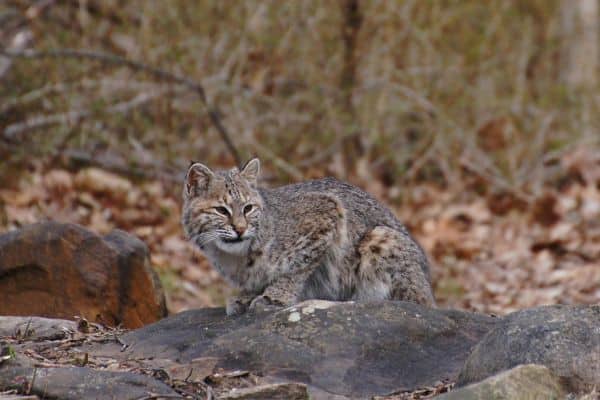
Hikers walking the Crosstown Trail or the Top Spur Trailhead, which connects to various trails, might be lucky enough to catch a fleeting glimpse of this elusive feline, especially during dawn or dusk.
Bobcats are versatile predators, feeding on a variety of prey like rodents, birds, and even larger mammals. They’re solitary creatures, known for their stealthy hunting techniques. Spotting a bobcat in the wild is a rare treat; their natural camouflage and secretive nature make them a challenging find.
However, knowing that such a skilled predator is sharing the same space is a reminder of the rich biodiversity of Mount Hood and the wild beauty that resides within its boundaries.
Northern Flying Squirrel
The Northern Flying Squirrel is one of Mount Hood National Forest’s nocturnal treasures. While they don’t truly “fly”, these squirrels use a skin flap, known as the patagium, to glide between trees with ease.
Typically weighing between 2 to 4 ounces, their large eyes are perfectly adapted for night vision, and their fur varies from brown to gray, helping them blend into the forest canopy.
For those keen on spotting these unique creatures, your best chances lie in areas with tall, mature coniferous trees. Sections of the Pacific Crest Trail (PCT) within Mount Hood, especially around the 10-mile stretch near Barlow Pass, have reported sightings.
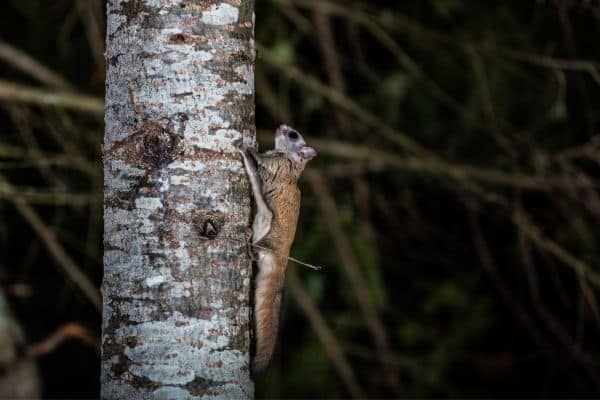
Additionally, the McNeil Point Trail, a 9.6-mile round trip, offers densely wooded areas where these squirrels are known to be active, particularly as the sun sets.
Northern Flying Squirrels have a varied diet, which includes fungi, lichen, insects, and seeds. As they forage, they play a pivotal role in dispersing fungal spores, supporting the forest’s health and growth.
If you’re hiking in Mount Hood during the evening or night, keep an eye (and ear) out for these elusive gliders.
Douglas Squirrel
In the diverse ecosystem of Mount Hood National Forest, the Douglas Squirrel, often referred to as the “chickaree,” is a small yet lively presence. Weighing about 5 to 10 ounces, these squirrels are distinguishable by their vibrant reddish-brown summer coat, which transitions to a grayer hue in winter.
Their underbellies remain a soft, creamy color year-round, and their assertive chatters can often be heard echoing through the trees.
For those interested in spotting these spirited creatures, they’re particularly fond of coniferous forests. The Twin Lakes Trail, a roughly 8-mile round-trip, and sections of the Yocum Ridge Trail, extending for about 10 miles, are among the prime locations where these squirrels are frequently observed.
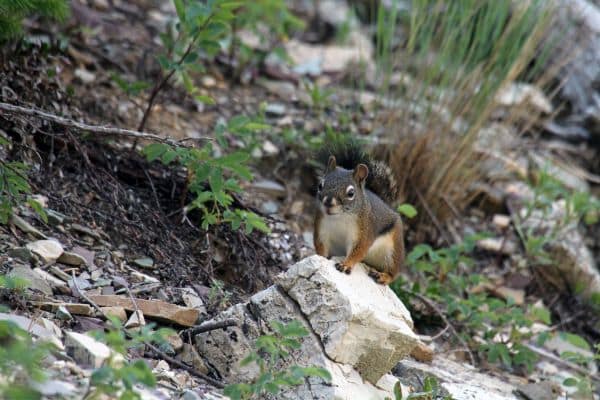
Their presence is particularly noticeable around pine cones, as they’re known to strip them down, leaving characteristic piles of cone scales beneath trees.
The diet of the Douglas Squirrel mainly consists of seeds, especially from conifers, but they also consume mushrooms, fruits, and some insects.
Their energetic antics and ceaseless chatter make them a delightful companion during hikes, adding vibrancy to Mount Hood’s vast expanses. If you’re on the trails and hear a loud, persistent chatter from above, chances are, you’ve got a Douglas Squirrel voicing its opinion nearby.
Snowshoe Hare
A master of camouflage within Mount Hood National Forest is the Snowshoe Hare. Named for its large, furry feet which act like natural snowshoes, this hare weighs between 2 to 4 pounds.
Its coat undergoes a seasonal transformation: a brownish-grey in summer allows it to blend with the underbrush, while a pure white winter coat helps it remain undetected in snowy landscapes.
For those eager to spot these elusive creatures, their preferred habitats are dense, shrubby areas that provide ample cover.
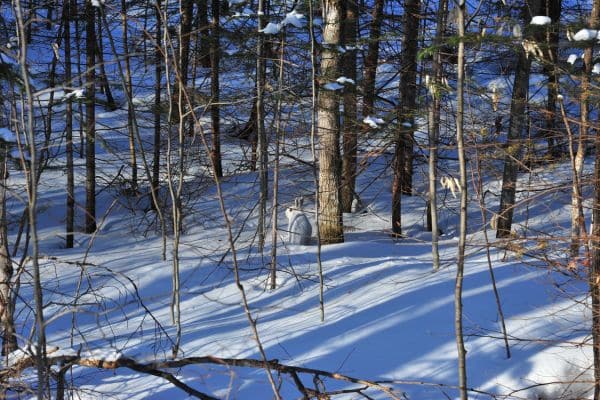
The Paradise Park Loop Trail, spanning about 12 miles, and portions of the Salmon River Trail, a scenic 14-mile pathway, often have signs of Snowshoe Hare activity, especially their distinctive tracks in the snow during winter months.
Snowshoe Hares primarily feed on a variety of vegetation including grasses, ferns, and shrubs. In the winter, they’ll turn to tree bark and twigs to sustain themselves. Being crepuscular, they’re most active during dawn and dusk.
While sightings can be rare due to their camouflaging coats and secretive nature, the thrill of spotting one in the wild, especially against a snowy backdrop, is a memory that sticks with hikers long after their Mount Hood journey concludes.
American Pika
One of the petite wonders of Mount Hood National Forest is the American Pika. These small, round-eared mammals, part of the rabbit family, usually weigh just 4 to 6 ounces.
They possess a grayish-brown fur coat which gives them an adorable, plush-like appearance. Their distinctive high-pitched calls, often likened to a sharp “eek”, can be a delightful sound echoing through rocky terrains.
If you’re hoping to catch a glimpse of these charming creatures, aim for the alpine and subalpine regions of the forest. The Cooper Spur Trail, a 6.4-mile hike that takes you through high-elevation terrains, and the rocky sections of Elk Cove Trail, spanning about 11 miles round trip, are promising spots to observe pikas, especially among the scattered talus slopes.
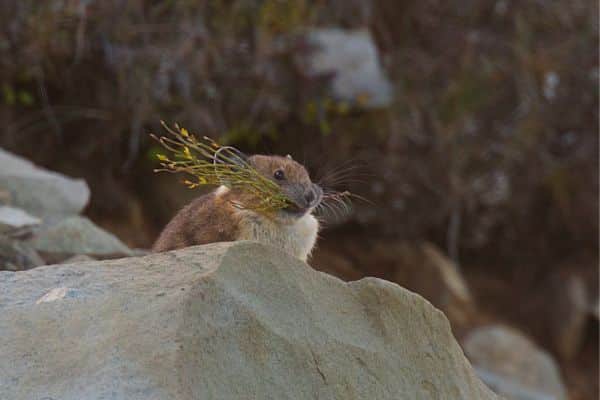
The diet of the American Pika primarily consists of grasses and wildflowers. What’s fascinating is their industrious nature. During the warmer months, you might spot them busily collecting and storing food in “haystacks” for the winter. Since they don’t hibernate, these reserves are vital for their survival in the colder months.
Encountering an American Pika, with its bustling energy and captivating calls, is a delightful highlight for any visitor exploring the higher elevations of Mount Hood National Forest.
Spotted Owl
A silent, nocturnal guardian of the Mount Hood National Forest, the Spotted Owl is a magnificent bird to behold. Medium-sized, with a weight range of 1 to 1.5 pounds, its deep brown plumage is adorned with distinct white spots, giving it its name.
With a rounded face and dark eyes, it exudes an air of mystery, often captivating the attention of bird enthusiasts and hikers.
For those with a keen interest in bird-watching, the old-growth forests within Mount Hood provide the best chance for spotting these elusive owls. Areas like Ramona Falls, along its 7-mile trail, and the dense woods near Cloud Cap Inn, are known habitats of the Spotted Owl.
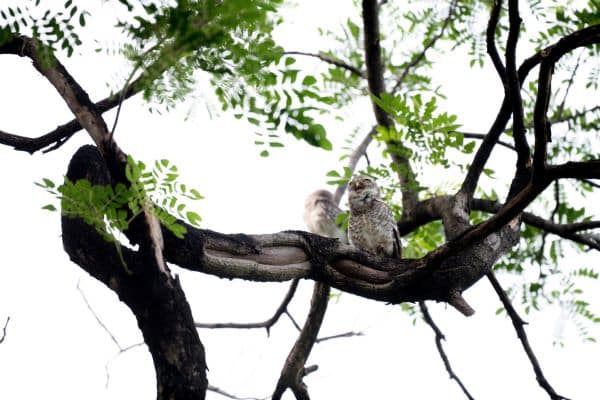
Evening hikes or early morning treks, particularly around the Tom Dick and Harry Mountain Trail, an 8-mile round trip, might reward you with the soft hoots or even a rare sighting of this bird.
The Spotted Owl’s diet primarily comprises small mammals, birds, and insects. Their hunting technique is one of silent precision, making them effective nocturnal predators.
With their numbers facing challenges due to habitat disruptions, seeing a Spotted Owl in its natural environment is both a privilege and a gentle reminder of the importance of preserving the integrity of these ancient forests for the myriad species that call it home.
Northern Goshawk
The Northern Goshawk is one of the fierce avian predators that soar the skies of Mount Hood National Forest. Medium to large in size, with an average weight between 1.5 to 3.5 pounds, this raptor showcases a striking appearance.
Its blue-gray upper parts contrast with its pale underbelly, which is streaked with darker bands. The bird’s piercing red eyes and robust build make it a formidable presence in the forest’s canopy.
Hikers and bird enthusiasts hoping to spot the Northern Goshawk should focus on the forest’s dense woodlands. The old-growth trees around Muddy Fork and the conifer-rich regions near Bull Run Watershed have been known to house nesting pairs.
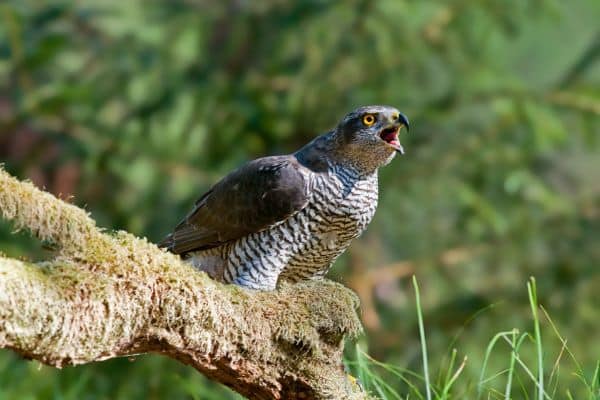
Trails such as the McGee Creek Trail, which stretches for about 9 miles, and sections of the Wildwood Recreation Site, provide suitable environments for goshawk activity.
The diet of the Northern Goshawk primarily consists of small mammals and birds. Their hunting prowess is evident in their swift and agile flight, often darting through trees with incredible precision to capture prey. They are known for their tenacity, often fearlessly defending their territory or nest.
While they might not be the most frequently spotted bird in the forest, the sheer thrill of witnessing a Northern Goshawk in action – be it in flight or while calling with its distinct voice – is an experience that resonates deeply with nature lovers exploring Mount Hood National Forest.
Mountain Bluebird
Adding a dash of vibrant color to the skies of Mount Hood National Forest is the Mountain Bluebird. This small bird, weighing only about an ounce, is a sight to behold with its brilliant blue feathers.
Males are particularly striking with brighter blue plumage, while females exhibit a more subdued gray-blue coloration with occasional hints of orange or rust beneath the wings and tail.
For those hoping to experience the delightful presence of these bluebirds, open, high-elevation areas with sparse tree coverage offer the best sightings. The meadows around Lookout Mountain and the open spaces near Tilly Jane Campground are prime territories for these birds.
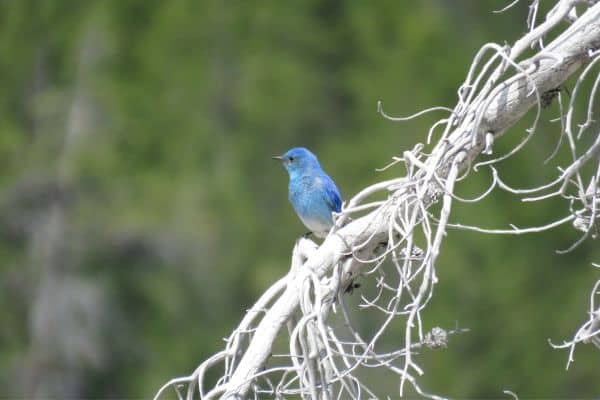
If you’re trekking along the High Prairie Trail, an approximately 10-mile loop, or exploring the vistas of the Vista Ridge Trailhead, spanning roughly 9 miles, keep an eye out for their characteristic blue flutter.
Mountain Bluebirds primarily feed on insects, using their keen eyesight to spot prey from perches or while in flight. Their presence is often a sign of the changing seasons; these birds migrate, making their way to Mount Hood during the warmer months.
The ethereal sight of a Mountain Bluebird against the backdrop of the forest’s vast landscapes is not just a visual treat but also a heartwarming testament to the rich avian diversity of the region.
American Dipper
The American Dipper, often referred to as the “Water Ouzel,” is a distinctive bird native to the freshwater streams and rivers of Mount Hood National Forest.
Weighing around 1.5 to 2 ounces, this songbird, clothed in a uniform gray plumage, might seem unassuming at first glance. However, its unique behavior of walking or “dipping” underwater in search of food sets it apart from other birds.
For those intrigued by this aquatic songbird, the fast-flowing streams and clear waters of Mount Hood are where you should cast your gaze. The cascading waters near Tamanawas Falls and the riverbanks of Eagle Creek are known habitats for the dipper.
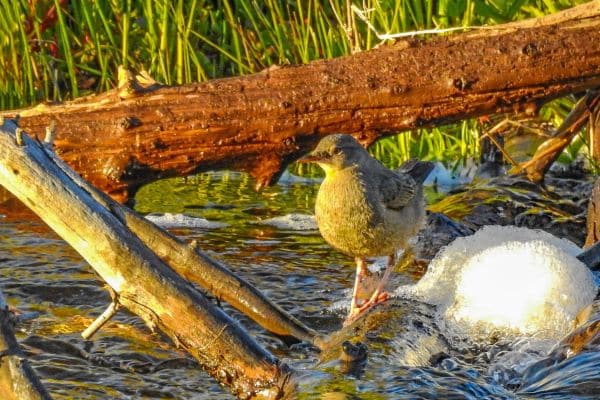
Trails like the Horsetail Falls Loop, a manageable 2.6-mile round trip, or the Oneonta Gorge, provide opportunities to observe these birds flitting about or perched on rocks, often near cascading water.
Primarily feeding on aquatic insects, larvae, and small fish, the American Dipper has a unique method of foraging. It dives into the water, using its wings to propel itself, and can even walk along the riverbed to pick out prey. Their presence in a water body often indicates good water quality.
Listening to their melodious song, punctuated by their characteristic dipping actions, while the waters of Mount Hood rush by, makes for a serene and almost meditative experience for any nature enthusiast.
Red Fox
Among the myriad of wildlife in Mount Hood National Forest, the Red Fox stands out with its iconic russet fur and bushy tail. A medium-sized carnivore, the Red Fox typically weighs between 6 to 15 pounds.
It sports a vibrant red coat, offset by white underparts and a distinctive white-tipped tail. Its pointed ears and cunning gaze often give it an expression of keen intelligence.
For those interested in spotting this elusive creature, open meadows and forest edges within the park offer the best opportunities. The grassy expanses near Bennett Pass and the woodland fringes of Clear Lake are among the favored haunts of the Red Fox.
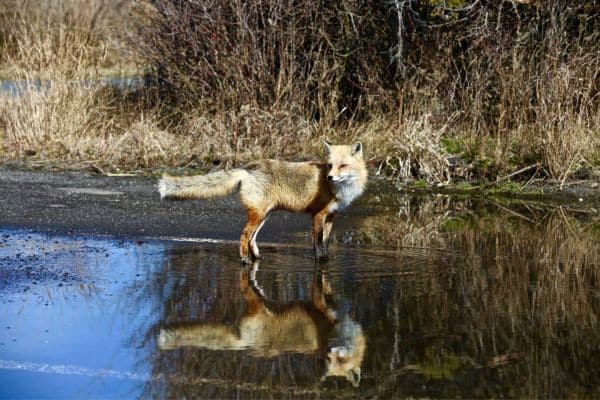
If you’re journeying along the Barlow Road Trail, a 6-mile stretch, or the pathways around Trillium Lake, be vigilant, especially during dawn or dusk, as these are prime times for fox activity.
Red Foxes are opportunistic feeders with a varied diet that includes rodents, rabbits, birds, and even berries. Their keen senses, especially hearing, allow them to locate and capture prey with remarkable precision.
Though sightings can be infrequent due to their mostly nocturnal habits and natural wariness, catching a glimpse of a Red Fox in its natural habitat is a memorable moment, a blend of beauty and wilderness, emblematic of the rich biodiversity of Mount Hood National Forest.
Pine Marten
The Pine Marten, a nimble and elusive inhabitant of Mount Hood National Forest, is a treat for the keen-eyed wildlife enthusiast. A member of the weasel family, this medium-sized mammal weighs between 1 to 3 pounds.
It boasts a slender body covered in rich brown fur that varies in shade, with a distinctive pale or yellowish patch on its throat. Its sharp features and bushy tail contribute to its agile and sleek appearance.
Those aiming to spot the Pine Marten should focus on the forest’s dense, mature coniferous areas. The old-growth regions around Lolo Pass and the dense woodlands near Buzzard Point are known to be favored territories for this mammal.
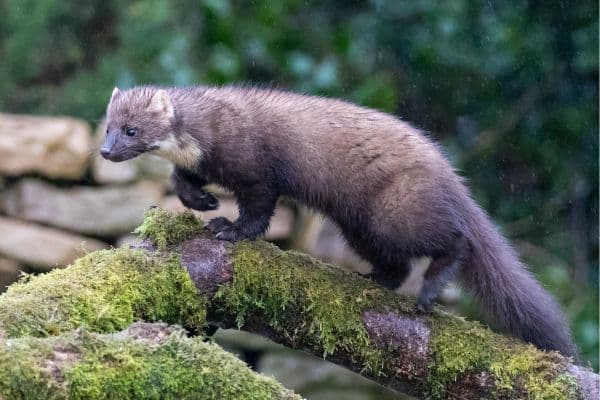
The Shadow Creek Trail, a 7-mile trek, and the paths winding through Roaring River Wilderness provide ample opportunities for potential sightings, particularly in the early morning or late afternoon when the Pine Marten is most active.
Diet-wise, Pine Martens are carnivorous, primarily feeding on small mammals, birds, and insects. However, they’re also known to indulge in fruits and berries when available.
Their agile and stealthy nature makes them effective hunters in the dense forests. A sighting of the Pine Marten, with its graceful movements and vibrant eyes, serves as a reminder of the intricate web of life and the hidden wonders within the vast expanses of Mount Hood National Forest.
Bald Eagle
A symbol of majesty and freedom, the Bald Eagle is one of the most iconic birds gracing the skies of Mount Hood National Forest.
This impressive raptor, with a wingspan that can reach up to 7.5 feet, exhibits a striking contrast with its dark brown body and bright white head and tail. Mature adults possess a sharp yellow beak and piercing eyes, making their profile unmistakable against the forest’s backdrop.
For those with aspirations of witnessing this majestic bird, the expansive water bodies and open skies of Mount Hood are your best bet. The shores of Lost Lake and the vast expanse around Timothy Lake are known hotspots where Bald Eagles often perch or soar in search of prey.
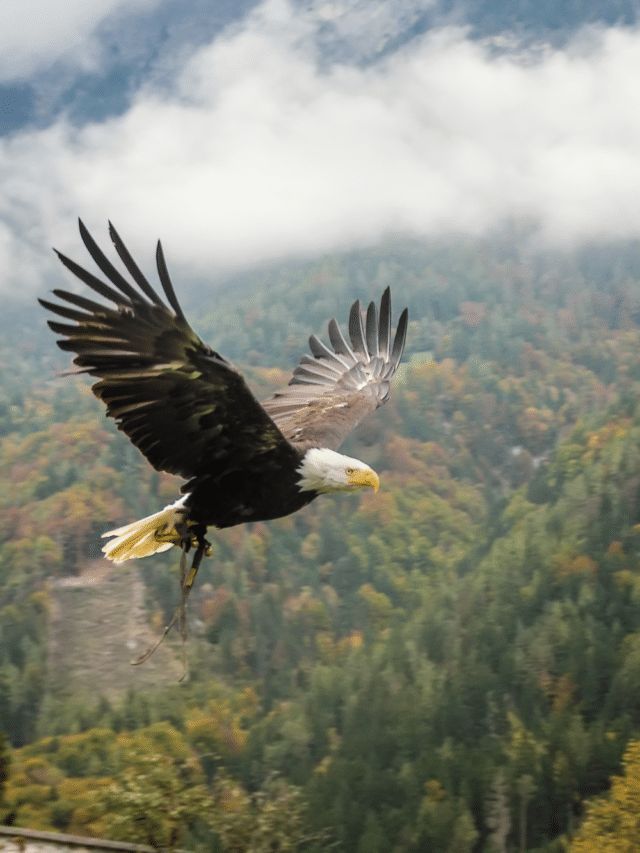
If you’re traversing the Burnt Granite Trail, a 10-mile round trip, or enjoying the vistas along the Clackamas Lake, be sure to scan the treetops and skies, especially during morning or late afternoon hours.
Primarily carnivorous, Bald Eagles feed on fish, making the lakes and rivers of Mount Hood their ideal hunting grounds. They can often be seen performing breathtaking aerial dives to capture fish with their powerful talons. Aside from their hunting prowess, witnessing their courtship displays, which involve intricate aerial acrobatics, is a sight to behold.
The presence of the Bald Eagle in Mount Hood National Forest not only underscores the region’s ecological richness but also offers visitors a chance to connect with a symbol deeply rooted in American heritage.
Osprey
The Osprey, often referred to as the “fish hawk,” is a remarkable avian presence in the skies of Mount Hood National Forest. This specialized bird of prey exhibits a wingspan of up to 6 feet and boasts a unique white underside contrasted with a dark brown back.
Its head features a distinct white crown, and a mask-like stripe runs across its eyes, giving it a commanding appearance.
For those hoping to observe this master fisher in action, areas around water bodies within Mount Hood are prime locations. Mirror Lake and Trillium Lake are known gathering spots for Ospreys, especially during their fishing expeditions.
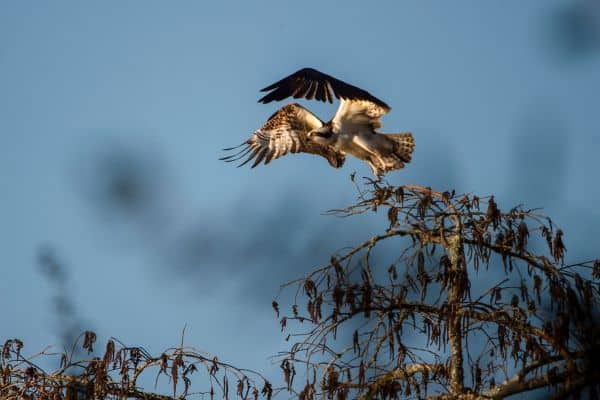
Trails such as the Zigzag Mountain Trail, which covers around 10 miles, and the pathways around Laurance Lake provide scenic vantage points where the Osprey’s aerial displays can be admired, particularly during their hunting dives.
Ospreys have an almost exclusive diet of fish. Their hunting technique is a spectacle in itself. They hover high above the water, and upon spotting their prey, they dive feet-first, plunging into the water to grasp fish with their strong, curved talons.
Once they have their catch, Ospreys have the unique ability to orient the fish headfirst for a more aerodynamic flight back to their perch or nest.
The sight of an Osprey, wings outstretched, clutching a fish and soaring against the backdrop of Mount Hood’s diverse landscapes, is an evocative image, capturing the essence of the wild and the interconnectedness of the forest’s ecosystem.
Western Tanager
Adding a splash of color to the verdant expanses of Mount Hood National Forest is the Western Tanager. This medium-sized songbird, typically weighing just under an ounce, is a visual delight.
Males are particularly striking with a vibrant yellow body, contrasting black wings, tail, and back, and a brilliant red head. Females, though more subdued in their yellow-green plumage, still capture attention with their graceful presence.
Birdwatchers and casual hikers alike can spot these beautiful birds in the forest’s open woodlands and edges. The areas around Salmon River and the canopy stretches of Rhododendron Ridge are known to attract Western Tanagers.
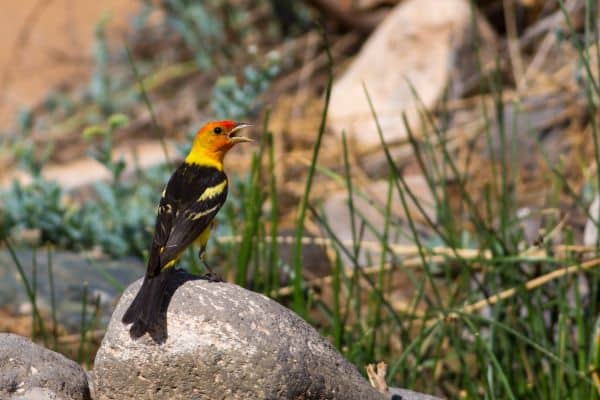
If you’re taking a hike on the Still Creek Trail, an approximately 6-mile journey, or wandering through the Old Maid Flat, be on the lookout for their vivid colors flitting amongst the trees, especially during the warmer months when they’re most active.
The diet of the Western Tanager is quite varied. While they primarily feed on insects during the breeding season, fruits become a significant part of their diet at other times. Their melodious song, a series of short musical phrases, often fills the air, adding to the serene ambiance of the forest.
Spotting a Western Tanager, with its dazzling colors contrasting against the greens of Mount Hood National Forest, is like finding a hidden gem, reminding visitors of nature’s endless palette of wonders.
Clark’s Nutcracker
The Clark’s Nutcracker, with its distinctive appearance and intriguing habits, is a notable feathered resident of Mount Hood National Forest.
This bird, usually weighing around 4 to 5 ounces, sports a primarily gray plumage, sharply contrasted by black wings and tail, and a striking white face and vent. Its sturdy, pointed bill and bright eyes give it a charismatic presence.
Those keen on observing this bird should explore the forest’s coniferous zones, especially areas with an abundance of pine trees. Timberline Lodge and its surrounding regions, as well as the wooded sections of Mount Defiance, are places where the Clark’s Nutcracker is frequently seen.
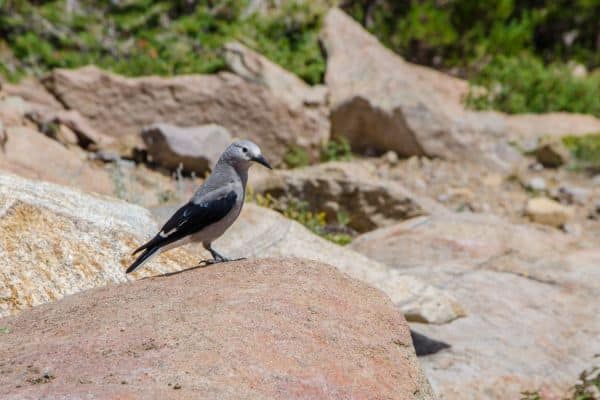
Hikers on the Twin Lakes Trail, an 8-mile adventure, or those exploring the Surveyor’s Ridge, might hear the bird’s loud, raspy calls echoing through the trees.
One of the most fascinating aspects of the Clark’s Nutcracker is its relationship with pine seeds, which form a significant part of its diet. The bird plays a vital role in seed dispersal, often storing thousands of seeds in ground caches for later consumption. Remarkably, it has an excellent memory and can relocate these caches months later.
This behavior not only ensures the bird’s survival during lean times but also aids in the propagation of pine trees within the forest.
Witnessing a Clark’s Nutcracker in its natural habitat, skillfully maneuvering between tree branches and burying or retrieving seeds, offers a glimpse into the delicate balance and intricate relationships within the ecosystems of Mount Hood National Forest.
Mule Deer
Among the larger inhabitants of Mount Hood National Forest, the Mule Deer stands out with its grace and characteristic large ears, which resemble those of a mule.
Typically weighing between 100 to 300 pounds, these deer exhibit a tawny brown coat, which serves as an effective camouflage against the backdrop of the forest. The white rump patch, black-tipped tail, and the branching antlers (in males) further distinguish them.
Hikers and nature enthusiasts keen on spotting Mule Deer should focus on the forest’s open meadows and clearings, especially during dawn or dusk when these herbivores are most active. The grassy expanses around Mount Hood Meadows and the clearings near Burnt Lake often witness deer activity.
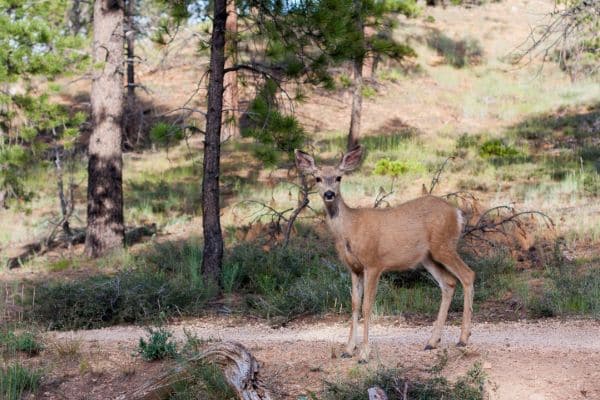
If you’re traversing the Elk Meadows Trail, a 6-mile loop, or wandering along the Sandy River, keep your eyes peeled for these majestic creatures grazing or resting in the shade.
Mule Deer primarily feed on a variety of vegetation, including shrubs, grasses, and even tree bark during leaner winter months.
Their keen senses, especially hearing and smell, often alert them to potential dangers, making them wary and sometimes challenging to approach. It’s always advised to observe from a distance and avoid any behavior that might stress or disturb them.
The sight of a Mule Deer, poised and alert, against the scenic beauty of Mount Hood National Forest, is a testament to the wilderness and rich biodiversity of the region.
Cascade Frog
The Cascade Frog, a lesser-known yet vital inhabitant of Mount Hood National Forest, is a gem for those interested in amphibians.
Typically measuring between 1.5 to 3 inches in length, this frog exhibits a green or brownish hue, often with distinctive black or dark blotches across its back. Its moist skin and large eyes give it the classic amphibian appearance, making it easily distinguishable from other fauna.
For those hoping to spot the Cascade Frog, the cool, high-altitude wetlands and ponds of the forest are where you should venture. The marshy edges of Umbrella Falls and the still waters near Tamanawas Falls are habitats these frogs favor.
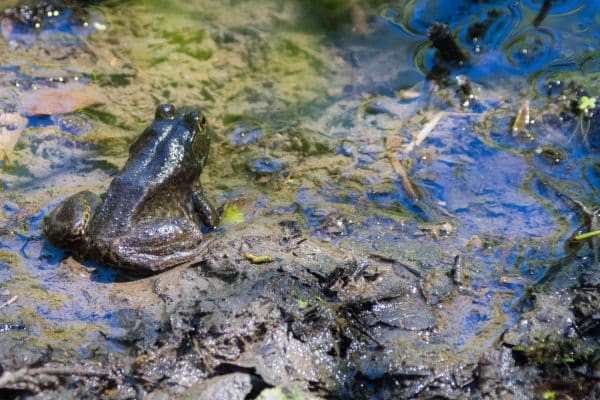
If you’re exploring the Alpine Meadow Trail, a 4-mile hike, or trekking along the Mazama Trail, be sure to listen for their characteristic croaks, especially during the breeding season.
Cascade Frogs primarily feed on various insects and their larvae, playing a vital role in controlling insect populations in their habitats. Their breeding sites, typically calm waters, will often have clusters of gelatinous egg masses floating close to the surface. These frogs, being cold-tolerant, have adapted well to the cooler climates of Mount Hood’s higher altitudes.
A chance encounter with a Cascade Frog, either by spotting one at the edge of a pond or hearing its call, offers a unique perspective on the intricate web of life in Mount Hood National Forest. Their presence reminds us of the importance of even the tiniest ecosystems and the delicate balance they maintain.
Overview of Mount Hood National Forest
Nestled in the Pacific Northwest region of the United States, Mount Hood National Forest spans over a million acres, providing an expansive natural playground for both locals and visitors alike.
Dominated by the impressive Mount Hood, which stands at a staggering 11,249 feet, this national forest is a testament to the diverse geography and topography of Oregon.
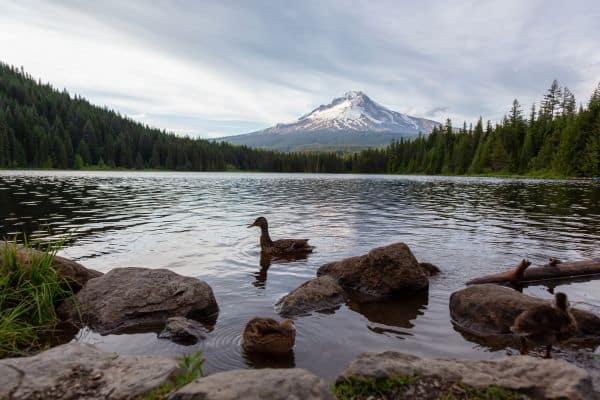
The landscape of Mount Hood National Forest is diverse and undulating, ranging from lush evergreen forests to alpine meadows, glacial-fed rivers, and rugged mountains.
Its topography is carved by the Cascades’ volcanic activity, which is notably represented by Mount Hood itself, an active stratovolcano and the highest peak in Oregon. This mix of terrains offers varied ecosystems, providing habitats for a myriad of plant and animal species.
Mount Hood National Forest boasts a rich history. Native American tribes, such as the Warm Springs, Yakama, and Nez Perce, called these lands home long before European settlers arrived. Their legacy, intertwined with the forest, lays in the ancient trails, hunting grounds, and spiritual sites.
Later, in the 19th century, pioneers traversed the Oregon Trail, with Mount Hood serving as a significant landmark. Recognizing its ecological and cultural importance, the U.S. government designated it a National Forest in 1908.
Today, Mount Hood National Forest stands not just as a recreational hub but also as a symbol of conservation and history. Its vast expanse continues to inspire awe, serving as a reminder of the raw, untamed beauty of nature and the legacy left behind by its ancient inhabitants.
Wilderness Areas in Mt Hood National Forest
Within the sprawling expanse of Mount Hood National Forest lie several designated wilderness areas, each with its unique features and ecological significance. One of the most renowned is the Mount Hood Wilderness, enveloping the majestic Mount Hood itself. This area is not only known for its breathtaking vistas but also for sightings of larger mammals, including the elusive Mountain Lions and Black Bears.
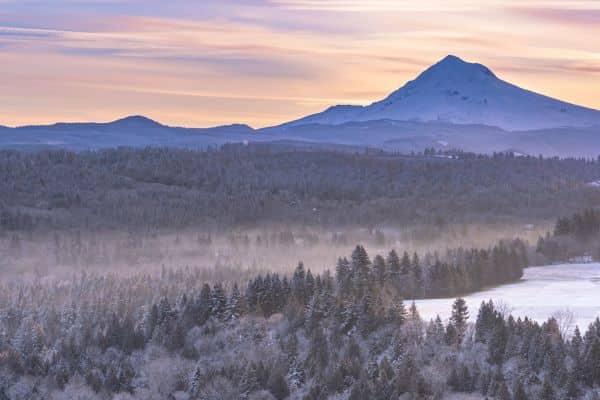
Adjacent to it is the Badger Creek Wilderness, a haven for bird enthusiasts. The dense woodlands and serene creeks here are frequented by species like the Spotted Owl and Northern Goshawk. The area’s rich biodiversity is complemented by the presence of deer, adding a touch of wilderness magic for visitors.
The Roaring River Wilderness, with its rugged terrains and fast-flowing rivers, is another wildlife-rich zone. The cascading waters here provide a suitable habitat for the American Dipper and the Cascade Frog, while the surrounding woodlands shelter creatures like the Pine Marten.
Moving further, the Salmon-Huckleberry Wilderness stands out with its dense, old-growth forests and the pristine Salmon River flowing through. It’s a hotspot for spotting the Western Tanager and American Pika, with the riverbanks often revealing signs of beaver activity.
The Bull of the Woods Wilderness offers a mosaic of terrains, from alpine meadows to pristine lakes. The clear waters here are often graced by the presence of Ospreys, while the meadows bloom with flora that attracts a plethora of insect species, making it a feeding ground for birds.
Mark O. Hatfield Wilderness, stretching along the Columbia River Gorge, is not only geographically unique but also a haven for the Mountain Bluebird and Clark’s Nutcracker, with its open spaces and rocky outcrops providing perfect perches.
Lastly, the Clackamas Wilderness, with its mix of dense forests and open spaces, offers a tranquil environment. Its calm waters and expansive meadows often reveal herds of Mule Deer grazing, while the skies above resonate with the calls of the Northern Goshawk.
10 Wildlife Trails in Mount Hood National Forest
Each of these wilderness areas, while preserving the pristine beauty of nature, also serves as a testament to Mount Hood National Forest’s rich biodiversity and the intricate tapestry of life within its boundaries.
Mount Hood National Forest, with its diverse ecosystems, is interspersed with numerous trails that offer an immersive experience into the heart of this wilderness, making it a hotspot for wildlife enthusiasts.

Timberline Trail is perhaps one of the most iconic, encircling the base of Mount Hood. Stretching for about 40 miles, this trail provides hikers with varied terrains from alpine meadows to glacial rivers. As one embarks on this lengthy hike, encounters with Roosevelt Elk and sightings of soaring Bald Eagles become frequent.
Close on its heels in popularity is the Ramona Falls Trail, an approximately 7-mile loop. Winding through old-growth forests and leading to the stunning Ramona Falls, this trail is a haven for birdwatchers, with the Spotted Owl often making an appearance amidst the dense canopy.
The Burnt Lake Trail, spanning roughly 7.5 miles round trip, leads to the serene Burnt Lake, surrounded by lush forests. The calm waters and forest edges are frequented by Mule Deer, and the melodic calls of the Western Tanager often fill the air.
A shorter but rewarding trail is the Tamanawas Falls Trail, covering around 3.6 miles. Leading to a spectacular waterfall, the damp environment around this trail attracts amphibians like the Cascade Frog.
Paradise Park Loop Trail, a 12-mile round trip, takes hikers through meadows bursting with wildflowers. These open spaces are playgrounds for the Snowshoe Hare, especially evident from their distinctive tracks in the snow.
Another trail, the Salmon River Trail, offers a 14-mile scenic pathway along the pristine Salmon River. This trail is a hotspot for bird enthusiasts, with the American Dipper frequently spotted diving into the river’s cool waters.
Cooper Spur Trail, which takes one through high-elevation terrains in its 6.4 miles, is a favored territory for the American Pika, especially among the scattered talus slopes.
The McGee Creek Trail, at about 9 miles, winds through dense woodlands, making it a prime location for wildlife sightings, including the nimble Pine Marten.
Elk Meadows Trail, a 6-mile loop, offers expansive meadows that are grazing grounds for herds of elk, while the skies above often have the Osprey circling, looking for prey.
Lastly, the Lost Creek Trail, spanning roughly 5 miles, moves through diverse terrains from dense forests to open spaces, providing ample opportunities for sightings of creatures like the Red Fox and the Douglas Squirrel.
Each trail in Mount Hood National Forest, with its unique features and potential wildlife encounters, promises hikers a journey of discovery and awe, offering intimate glimpses into the forest’s rich tapestry of life.
Best Time to See Wildlife in Mount Hood National Forest
In the ever-changing tableau of Mount Hood National Forest, each season unveils a unique canvas of nature, offering varied opportunities to witness its rich wildlife.
However, if one were to choose the prime time for wildlife sightings, fall would undoubtedly take the crown.
Fall: There’s a certain magic in the air during the autumn months in Mount Hood National Forest. As the leaves turn shades of gold and crimson, the forest witnesses increased animal activity, making it the best time for wildlife enthusiasts.
Animals are actively preparing for the approaching winter, ensuring more frequent sightings as they forage, hunt, and gather resources. The cooler temperatures also mean that animals are more active throughout the day.
The meadows around Bennett Pass or the clearings near Clear Lake often teem with herds of Mule Deer and Elk, their majestic antlers a sight to behold against the backdrop of fall foliage. The lower water levels in streams and rivers during this season make it easier to spot birds like the American Dipper, fishing for aquatic prey.
Winter: As the forest gets blanketed in snow, wildlife activity tends to taper off with many animals going into hibernation or becoming less active.
However, this is the perfect time to spot tracks and signs in the snow, offering a silent narrative of the forest’s winter life.
The areas near Timberline Lodge might give you a rare glimpse of the Snowshoe Hare, its white winter coat blending seamlessly with the snow.
Spring: As the snow melts and the forest comes alive with the sounds and colors of spring, animals begin to emerge from their winter hideouts. Newborn animals and birds can often be spotted during this season.
The Salmon River Trail is especially vibrant, with birdsong accompanying hikers on their journey.
Summer: While the forest is lush and teeming with life, the warmer temperatures can mean that many animals are less active during the day, preferring the cooler dawn and dusk hours.
The marshy edges of Umbrella Falls come alive with amphibians, and the higher altitudes, like Lolo Pass, offer respite from the heat for many animals.
While every season in Mount Hood National Forest has its charm and unique wildlife encounters, fall stands out as the golden period. The combination of pleasant weather, active wildlife, and the breathtaking beauty of autumn foliage ensures an unparalleled experience for any nature lover.
12 Tips for Wildlife Sightings in Mount Hood National Forest
- Understanding Animal Activity Patterns: Most wildlife species are crepuscular, meaning they are most active during dawn and dusk. This is primarily to avoid the midday heat and to capitalize on feeding times when their prey is most active. So, set your alarm early or plan an evening hike to increase your chances of encounters.
- Minimize Noise and Movement: Silence is golden when observing wildlife. Any sudden movements or loud noises can startle animals and drive them away. When you’re hiking and hear or see signs of nearby wildlife, slow down, tread softly, and speak in hushed tones.
- Safety First: Always maintain a safe distance from wildlife. Approaching too closely can be dangerous for both you and the animal. Animals such as elk or bears can become aggressive if they feel threatened or cornered. Remember, it’s their home, and we are the visitors.
- Invest in Optics: A good pair of binoculars or a spotting scope can significantly enhance wildlife viewing. They allow you to observe animals from a distance without disturbing them. It’s especially useful for birdwatchers, enabling clearer views of distant or small species.
- Learn to Identify Animal Tracks and Signs: Familiarize yourself with the common tracks, droppings, and feeding signs of the animals native to the area. This not only increases your chances of spotting them but also enriches the overall hiking experience, turning it into a tracking adventure.
- Dress Appropriately: Wear earth-toned or camouflage clothing to blend in with the environment. Bright colors can be easily spotted by animals and may deter them from coming close. Also, ensure you’re wearing quiet fabrics that don’t rustle loudly with each movement.
- Stay Downwind: Many animals have an acute sense of smell. If you’re upwind, they’ll likely catch your scent and retreat before you even know they’re there. Always check the wind direction and try to approach wildlife viewing spots from a downwind position.
- Use Natural Covers: When trying to observe wildlife, use natural features like trees, bushes, or terrain contours to mask your presence. Such covers can help you get closer without being detected.
- Be Patient: Sometimes, the key to a successful wildlife sighting is patience. Find a promising spot, make yourself comfortable, and wait. Over time, the forest will return to its natural rhythm, and animals will emerge.
- Educate Yourself: Before visiting, research the animals you’re likely to encounter. Understand their habitats, behaviors, and feeding patterns. The more you know, the better equipped you’ll be to spot them.
- Leave No Trace: Always adhere to the ‘Leave No Trace’ principles. Not only does this ensure the preservation of habitats, but it also ensures animals don’t become accustomed or wary of human presence, making future sightings more likely for others.
- Participate in Guided Tours: If available, consider joining a guided wildlife tour or walk. Local guides have extensive knowledge about the best spots and times for wildlife sightings. Plus, they’ll provide invaluable insights into animal behaviors and the forest’s ecology.
Incorporating these tips into your Mount Hood National Forest visit will not only enhance your chances of memorable wildlife encounters but will also ensure that your presence has a minimal impact on the natural behaviors and habitats of these incredible creatures.
Conclusion
Mount Hood National Forest, with its vast landscapes and intricate ecosystems, stands as a testament to nature’s splendor. From its towering peaks to its hidden valleys, every corner whispers tales of the wild, waiting to be discovered. As we’ve journeyed through the trails and acquainted ourselves with its varied inhabitants, it’s evident that this forest is more than just a tourist destination; it’s a living, breathing sanctuary of biodiversity.
For hikers, birdwatchers, and wildlife enthusiasts, each visit offers a new revelation, a fresh perspective. Whether it’s the graceful flight of the Bald Eagle, the elusive stride of the Red Fox, or the serene croak of the Cascade Frog, Mount Hood ensures an experience that resonates deep within, reminding us of our intrinsic connection to the natural world.
But as we marvel at its wonders, let’s also remember our responsibility. To tread lightly, to respect its inhabitants, and to ensure that our explorations leave no trace. For in preserving the sanctity of Mount Hood National Forest, we not only safeguard a piece of Earth’s natural heritage but also gift future generations the same sense of wonder and discovery that we cherish today.
So, as you lace up your boots for your next adventure or reminisce about past hikes, know that Mount Hood National Forest awaits, timeless and enduring, a haven where nature’s stories unfold, one step at a time.

